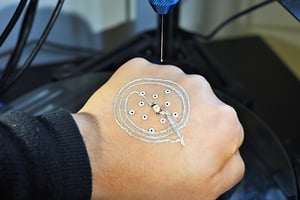The evolution of the 3D printer is an object that, according to its inventor, Michael McAlpine of the University ofl Minnesota (USA), can fit in your pocket like a Swiss army knife and, if necessary, can use skin (of the hand, for example) as a basis for printing small electronic circuits to be allocated to sensors (in order to reveal chemical or biological agents, or for other biomedical purposes), but also solar mini-cells to charge cell phones. These possibilities will be useful, explains McAlpine, especially for soldiers at war. However, the new device can also make it possible to “print” regenerative tissue on skin wounds (successful tests were performed on laboratory animals) or other types of grafting for disorders. The special small, lightweight and portable 3D printer also costs little: approximately 400 dollars, and in the future could cost even less and become popular – say the researchers guided by McAlpine, who published the results of their studies in the journal Advanced Materials. One of the key innovations of the new printer is that it can adjust to small movements of the body during printing (a characteristic that is not possessed by other 3D printers. In fact, these machines usually have to remain completely still without moving). In order to obtain these results, however, several temporary “markers” (which can be easily removed, when they are no longer needed) need to be placed on the skin, and the mini 3D printer then uses a kind of artificial vision to adjust to the movements. “You don’t have to remain completely still when you are using the printer on your skin – explained McAlpine – The machine is able to “trace” the hand using these markers and to adjust to movements in real time, so the printing of the electronic circuits is highly accurate”.
Another unique feature of this new device is that it uses a special “ink” made of silver flakes, that can cure and conduct well even at room temperature, whereas the ink in other 3D printers almost always has to “cure” at high temperatures (up to 100 degrees Celsius). However, in this case the skin of the hand would be burnt and it would be impossible to “print” the electronic circuits.

